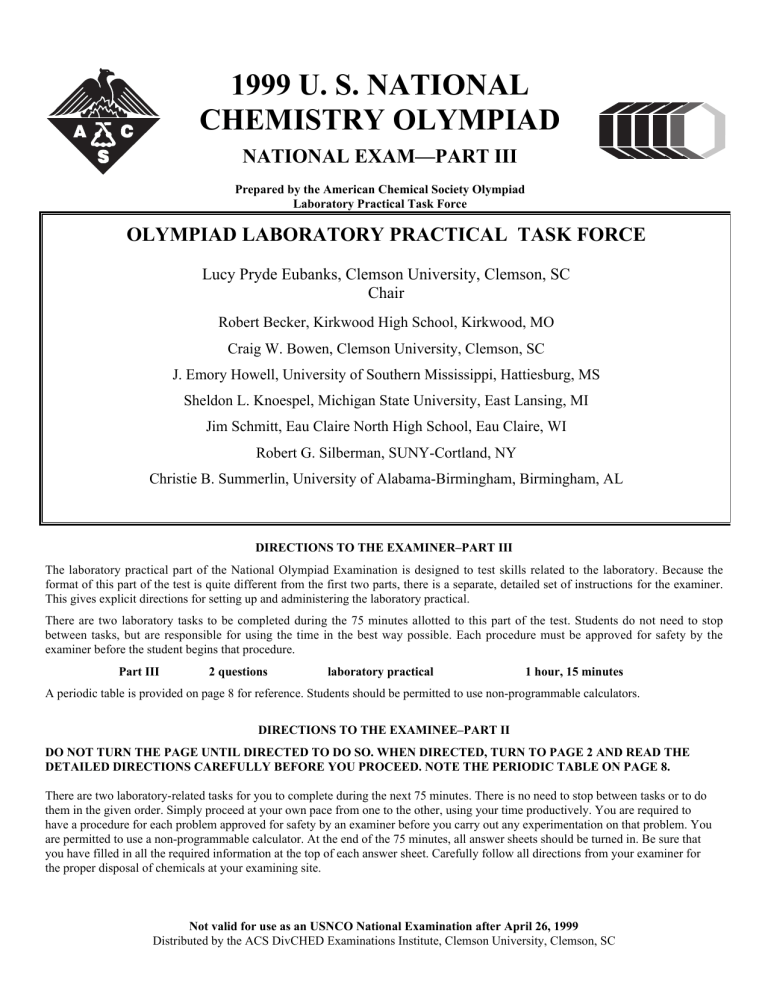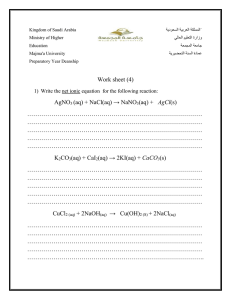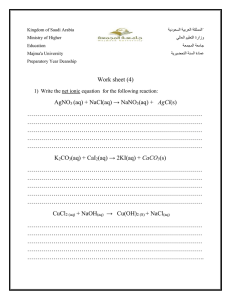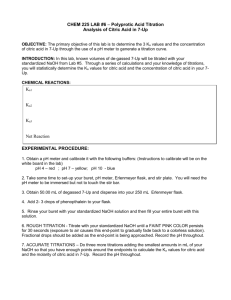1999-usnco-exam-part-iii
advertisement

1999 U. S. NATIONAL CHEMISTRY OLYMPIAD NATIONAL EXAM—PART III Prepared by the American Chemical Society Olympiad Laboratory Practical Task Force OLYMPIAD LABORATORY PRACTICAL TASK FORCE Lucy Pryde Eubanks, Clemson University, Clemson, SC Chair Robert Becker, Kirkwood High School, Kirkwood, MO Craig W. Bowen, Clemson University, Clemson, SC J. Emory Howell, University of Southern Mississippi, Hattiesburg, MS Sheldon L. Knoespel, Michigan State University, East Lansing, MI Jim Schmitt, Eau Claire North High School, Eau Claire, WI Robert G. Silberman, SUNY-Cortland, NY Christie B. Summerlin, University of Alabama-Birmingham, Birmingham, AL DIRECTIONS TO THE EXAMINER–PART III The laboratory practical part of the National Olympiad Examination is designed to test skills related to the laboratory. Because the format of this part of the test is quite different from the first two parts, there is a separate, detailed set of instructions for the examiner. This gives explicit directions for setting up and administering the laboratory practical. There are two laboratory tasks to be completed during the 75 minutes allotted to this part of the test. Students do not need to stop between tasks, but are responsible for using the time in the best way possible. Each procedure must be approved for safety by the examiner before the student begins that procedure. Part III 2 questions laboratory practical 1 hour, 15 minutes A periodic table is provided on page 8 for reference. Students should be permitted to use non-programmable calculators. DIRECTIONS TO THE EXAMINEE–PART II DO NOT TURN THE PAGE UNTIL DIRECTED TO DO SO. WHEN DIRECTED, TURN TO PAGE 2 AND READ THE DETAILED DIRECTIONS CAREFULLY BEFORE YOU PROCEED. NOTE THE PERIODIC TABLE ON PAGE 8. There are two laboratory-related tasks for you to complete during the next 75 minutes. There is no need to stop between tasks or to do them in the given order. Simply proceed at your own pace from one to the other, using your time productively. You are required to have a procedure for each problem approved for safety by an examiner before you carry out any experimentation on that problem. You are permitted to use a non-programmable calculator. At the end of the 75 minutes, all answer sheets should be turned in. Be sure that you have filled in all the required information at the top of each answer sheet. Carefully follow all directions from your examiner for the proper disposal of chemicals at your examining site. Not valid for use as an USNCO National Examination after April 26, 1999 Distributed by the ACS DivCHED Examinations Institute, Clemson University, Clemson, SC 1999 UNITED STATES NATIONAL CHEMISTRY OLYMPIAD PART III — LABORATORY PRACTICAL Student Instructions Introduction These problems test your ability to design and carry out laboratory experiments and to draw conclusions from your experimental work. You will be graded on your experimental design, on your skills in data collection, and on the accuracy and precision of your results. Clarity of thinking and communication are also components of successful solutions to these problems, so make your written responses as clear and concise as possible. Safety Considerations You are required to wear approved eye protection at all times during this laboratory practical. You also must follow all directions given by your examiner for dealing with spills and with disposal of wastes. Lab Problem 1 You have been given a sample of 7-Up® that has been allowed to stand open. You also have been provided with some table sugar (sucrose), distilled or deionized water, some measuring devices, and a variety of containers. Graph paper has been provided on page 5 of this test booklet. Devise and carry out an experiment to determine the percent by mass of sugar in a sample of 7-Up. You will be asked to describe the method you developed to solve this problem. Given: The molar mass of sucrose, C12H22O11, is 342.30 g·mol–1 . Lab Problem 2 You have been given a sample of Crystal Drano®. There are two components in the Drano – some small shiny metallic pieces, and some pale green beads. (The green color is a dessicating substance.) The metallic pieces are either zinc, magnesium, or aluminum. The beads are either NaOH, Ca(OH)2, or Al(OH)3. You also have 1.0 M NaOH, 3.0 M HCl, and some phenolphthalein indicator. Devise and carry out an experiment to identify both components of Crystal Drano. You will be asked to describe the method you developed to solve this problem. Special Safety Consideration: Crystal Drano is quite caustic and must only be handled with the scoops or spatulas provided. Also, Crystal Drano will readily absorb moisture from the air so only open the container when you need a sample. Recap the container as quickly as possible. Page 2 Answer Sheet for Laboratory Practical Problem 1 Student's Name: __________________________________________________________________________ Student's School:________________________________________ Date: ___________________________ Proctor's Name: _________________________________________________________________________ ACS Section Name :________________________________Student's USNCO test #: ________________ 1. Give a brief description of your experimental plan. List the equipment and materials you plan to use and the steps you plan to take to solve this problem. Before beginning your experiment, you must get approval (for safety reasons) from the examiner. 2. Record your data and other observations. Page 3 Examiner’s Initials: 3. Calculate the percent by mass of sugar in 7-Up. You may choose to use the graph paper on the next page. Show your methods clearly. Percent by mass sucrose in 7-Up® 4. Explain what assumptions were made in determining the mass percent of sugar in 7-Up. How does each assumption influence the mass percent you calculated? Page 4 Graph Paper for Possible Use with Laboratory Practical Problem 1 Page 5 Answer Sheet for Laboratory Practical Problem 2 Student's Name: __________________________________________________________________________ Student's School:________________________________________ Date: ___________________________ Proctor's Name: _________________________________________________________________________ ACS Section Name : ________________________________Student's USNCO test #: ________________ 1. Give a brief description of your experimental plan. List the equipment and materials you plan to use and the steps you plan to take to solve this problem. Before beginning your experiment, you must get approval (for safety reasons) from the examiner. 2. Record your data and other observations. Page 6 Examiner’s Initials: 3. Identify the two components of Crystal Drano. Support your choices with conclusions drawn from your observations. Identification of metallic pieces: ____________________________________ Identification of beads: ____________________________________ Page 7 PERIODIC TABLE OF THE ELEMENTS 1 H 2 He 1.008 4.003 3 Li 4 Be 5 B 6 C 7 N 8 O 9 F 10 Ne 6.941 9.012 10.81 12.01 14.01 16.00 19.00 20.18 11 Na 12 Mg 13 Al 14 Si 15 P 16 S 17 Cl 18 Ar 22.99 24.31 26.98 28.09 30.97 32.07 35.45 39.95 19 K 20 Ca 21 Sc 22 Ti 23 V 24 Cr 25 Mn 26 Fe 27 Co 28 Ni 29 Cu 30 Zn 31 Ga 32 Ge 33 As 34 Se 35 Br 36 Kr 39.10 40.08 44.96 47.88 50.94 52.00 54.94 55.85 58.93 58.69 63.55 65.39 69.72 72.61 74.92 78.96 79.90 83.80 37 Rb 38 Sr 39 Y 40 Zr 41 Nb 42 Mo 43 Tc 44 Ru 45 Rh 46 Pd 47 Ag 48 Cd 49 In 50 Sn 51 Sb 52 Te 53 I 54 Xe 85.47 87.62 88.91 91.22 92.91 95.94 (98) 101.1 102.9 106.4 107.9 112.4 114.8 118.7 121.8 127.6 126.9 131.3 55 Cs 56 Ba 57 La 72 Hf 73 Ta 74 W 75 Re 76 Os 77 Ir 78 Pt 79 Au 80 Hg 81 Tl 82 Pb 83 Bi 84 Po 85 At 86 Rn 132.9 137.3 138.9 178.5 181.0 183.8 186.2 190.2 192.2 195.1 197.0 200.6 204.4 207.2 209.0 (209) (210) (222) 87 Fr 88 Ra 89 Ac 104 Rf 105 Db 106 Sg 107 Bh 108 Hs 109 Mt 110 111 112 114 (223) 226.0 227.0 (261) (262) (263) (262) (265) (266) (269) (272) (277) (289) 58 Ce 59 Pr 60 Nd 61 Pm 62 Sm 63 Eu 64 Gd 65 Tb 66 Dy 67 Ho 68 Er 69 Tm 70 Yb 71 Lu 140.1 140.9 144.2 (145) 150.4 152.0 157.3 158.9 162.5 164.9 167.3 168.9 173.0 175.0 90 Th 91 Pa 92 U 93 Np 94 Pu 95 Am 96 Cm 97 Bk 98 Cf 99 Es 100 Fm 101 Md 102 No 103 Lr 232.0 231.0 238.0 237.0 (244) (243) (247) (247) (251) (252) (257) (258) (259) (260) Page 8 1999 U. S. NATIONAL CHEMISTRY OLYMPIAD NATIONAL EXAM—PART III Prepared by the American Chemical Society Olympiad Laboratory Practical Task Force ANSWER KEYS Lab Problem 1 5 pts Plan is expected to include: • method to measure density of 7-Up® • method for determining the composition of sugar in water. • method to compare 7-Up solution to the known sugar/water mixtures. • replications of values of data expected. 8 pts Analysis of sugar/water solutions is expected to include: • data to support the method chosen for determining the composition of the sugar/water solutions. • multiple samples. • volume changes. • well-organized data tables . 6 pts Analysis of 7-Up solution is expected to include: • data to support the method chosen for determining the composition of the 7-Up. • replications of samples. 4 pts Results are expected to include: • clear explanations of calculations used to evaluate data. • reasonable results. Example of a reasonable approach (other approaches were evaluated as possibly acceptable): • Determine mass and volume of samples of 7-Up from which an average density value can be determined. • Determine mass and volume of a wide variety of sugar/water mixtures. Use these data to determine the density and corresponding mass % solute values of these mixtures. • Determine mass a volume of a wide variety of sugar/water mixtures. Use these data to determine the density and corresponding mass % solute for sugar/water mixtures. • Having the calculated average density value for 7_Up, use the graph to determine the mass % of 7-Up. • Data points on graph should bracket the 7-Up value. • Graph paper should be used efficiently. 2 pts Discussion of assumptions made should include: • recognition that other components may be present in the 7-Up other than sucrose. • limitations inherent in the methodology and equipment. Page 9 Lab Problem 2 5 pts Plan is expected to include: • method to separate the metal and green beads in Crystal Draino®. • method for testing the metal with water, HCl, and NaOH. • method to testing the green beads with water. • replications of tests. 8 pts Observations are expected to include that: • the green beads dissolve in water. • the metal turns black in water. • the metal reacts with both HCl and NaoH, forming bubbles. • well-organized observation tables . 12 pts Identification and support section is expected to include: • Reasoning for selecting NaOH. • The green beads dissolved easily in water, so the beads must be NaOH. Neither Ca(OH)2 nor Al(OH)3 are soluble in water. • Using 3 M HCl, a titration can be done to determine the amount of hydroxide in the beads. • Reasoning for selecting Al • All three possible metals would react with 3M HCl, so qualitative observations of reaction with HCl are not definitive. • Only Zn and Al react with 1 M NaOH. Because the metal is observed to react with NaOH, the Mg can be eliminated. • To distinguish between Zn and Al, a quantitative titration can be done with 1 M NaOH or with the 3M HCl. Page 10


